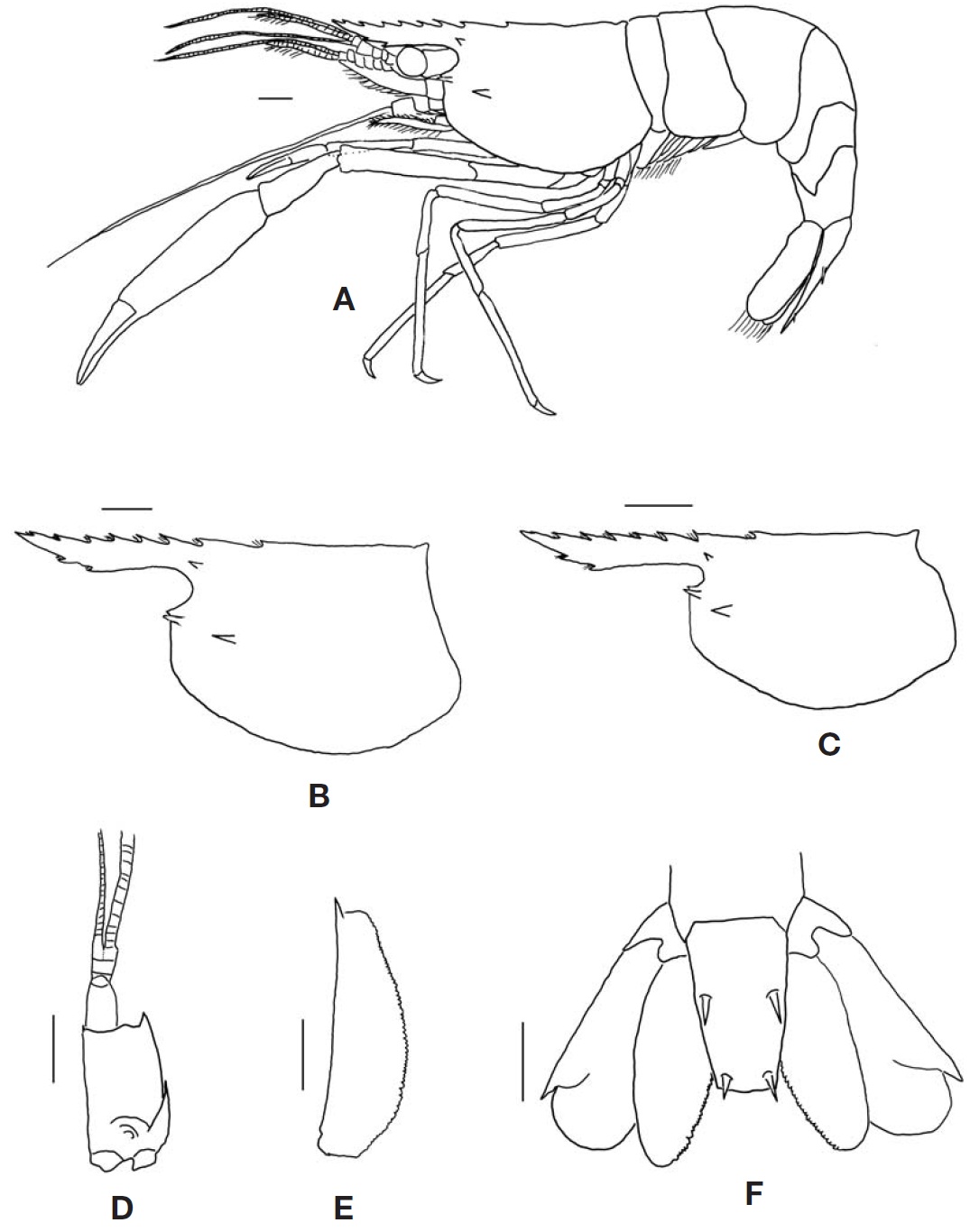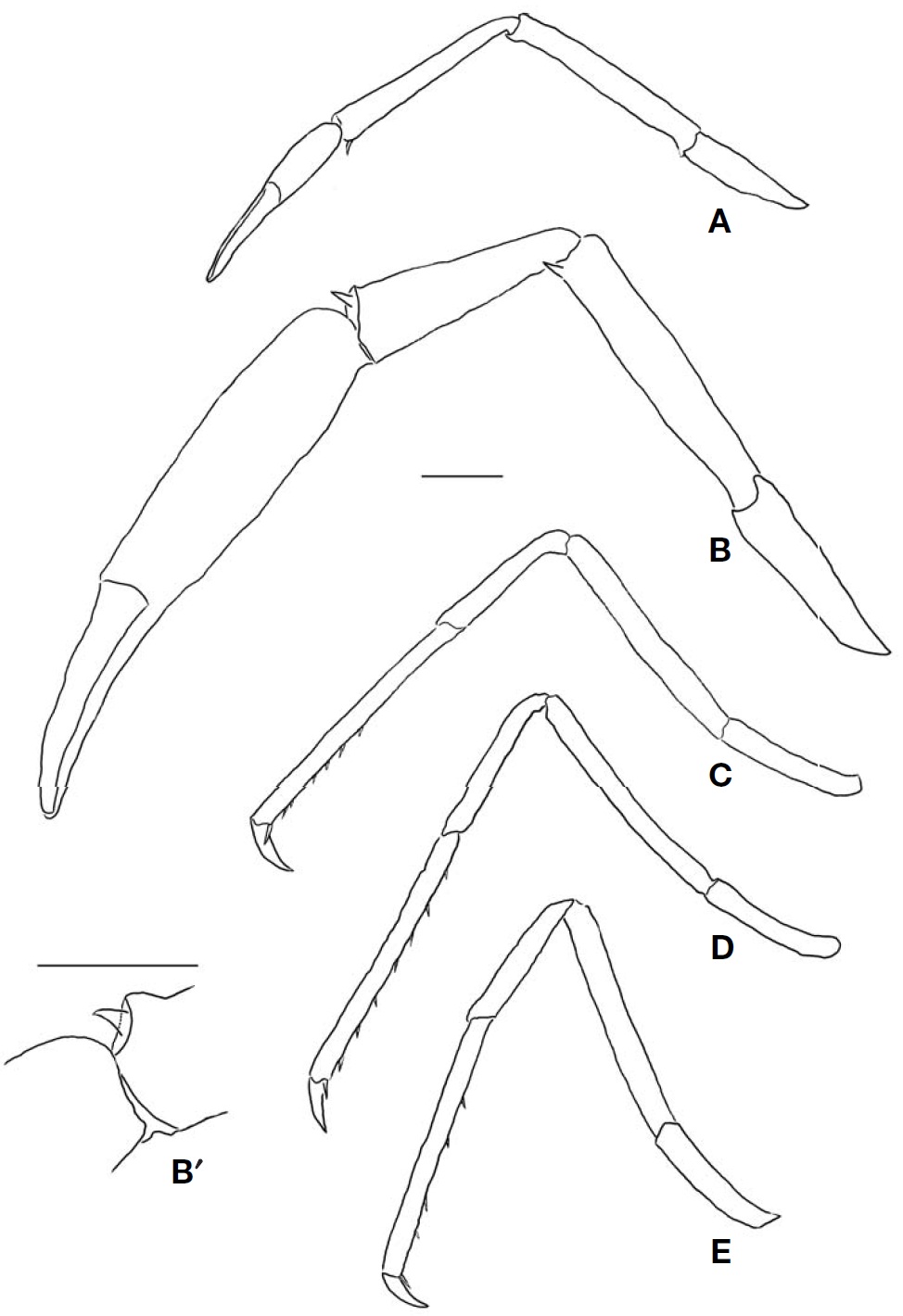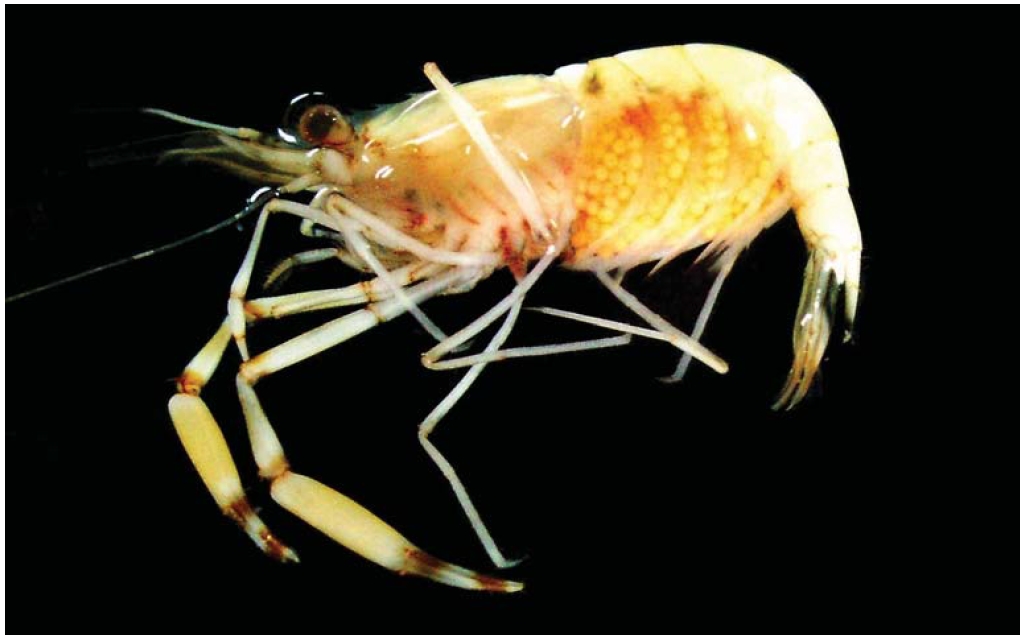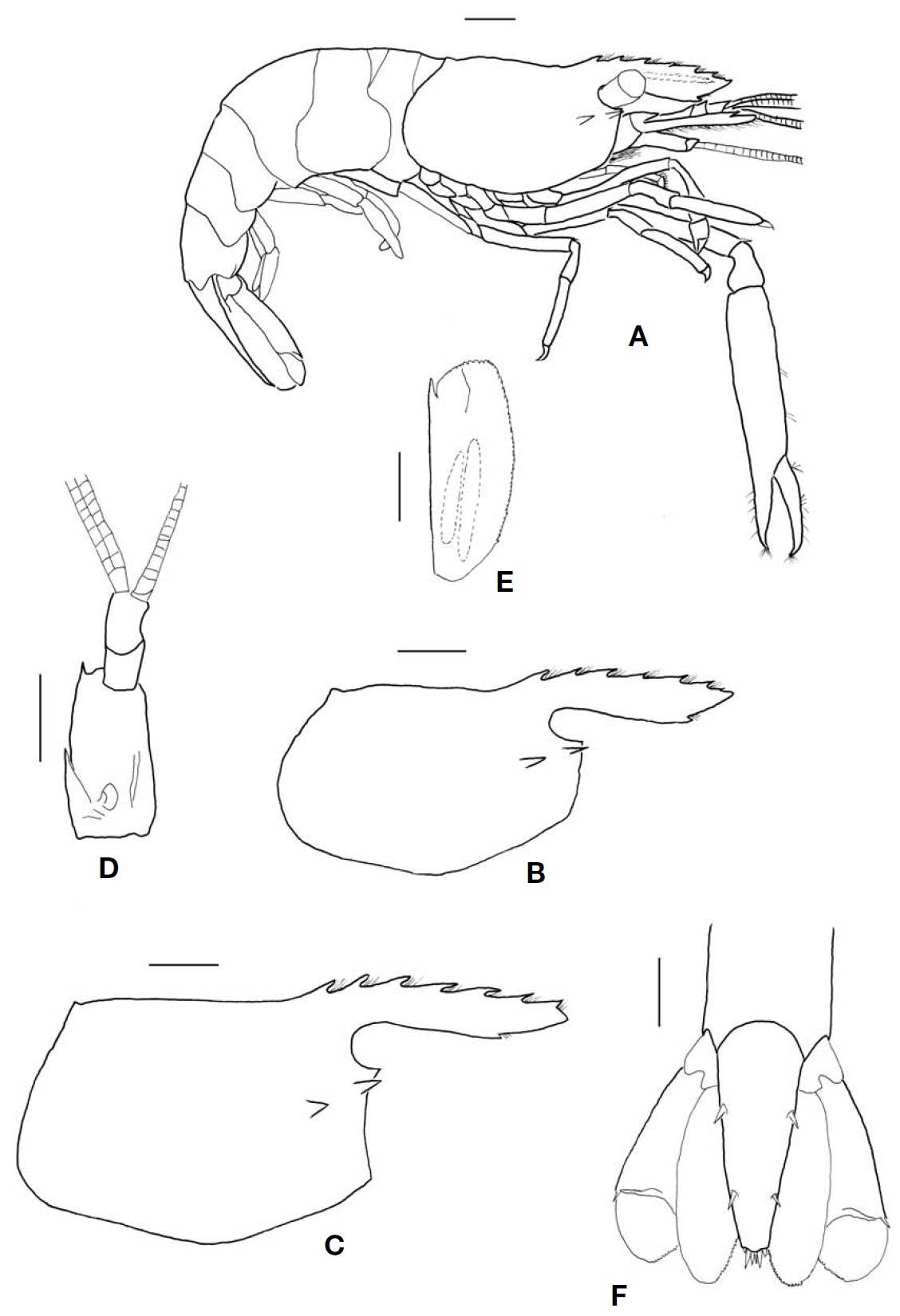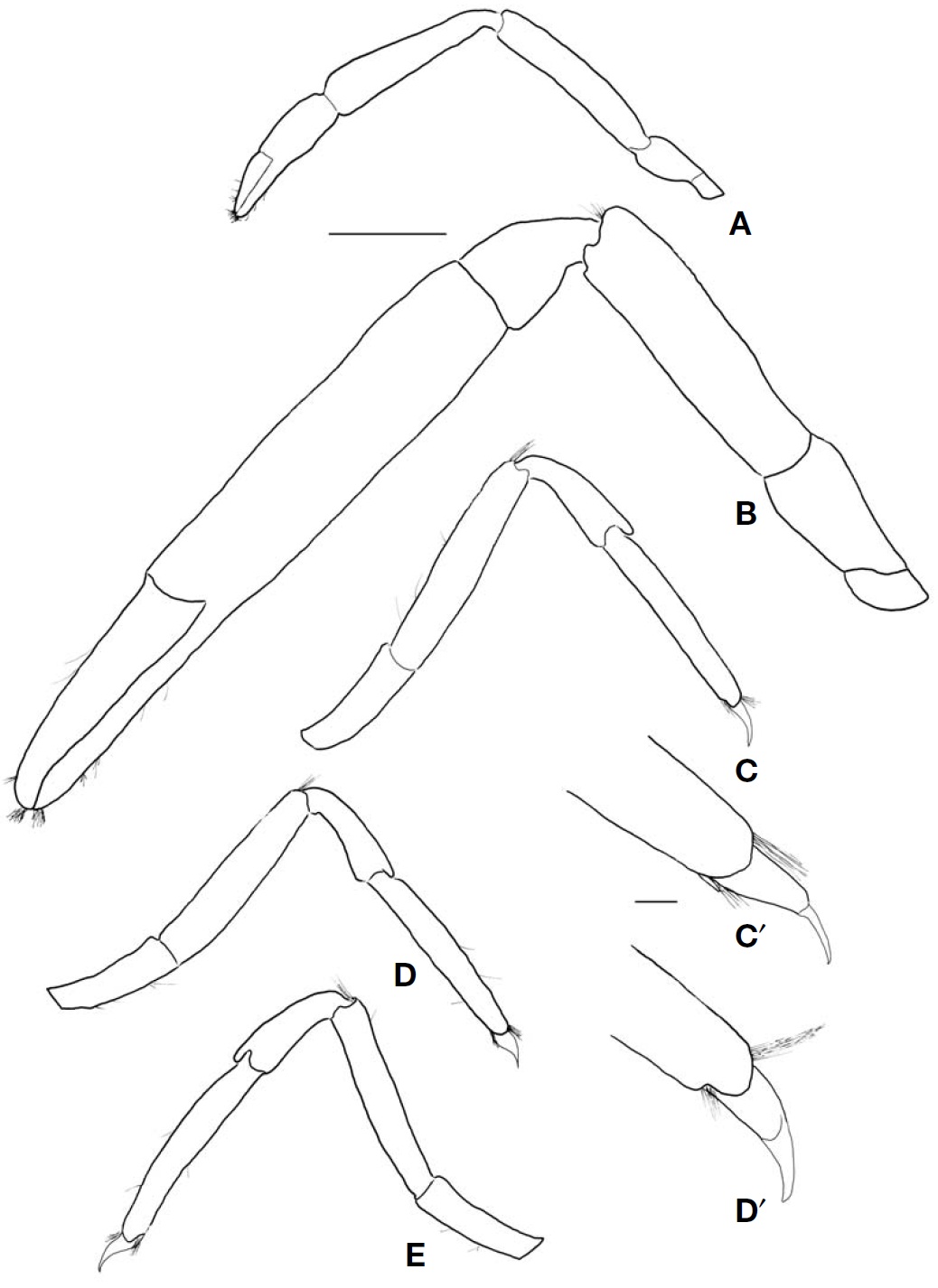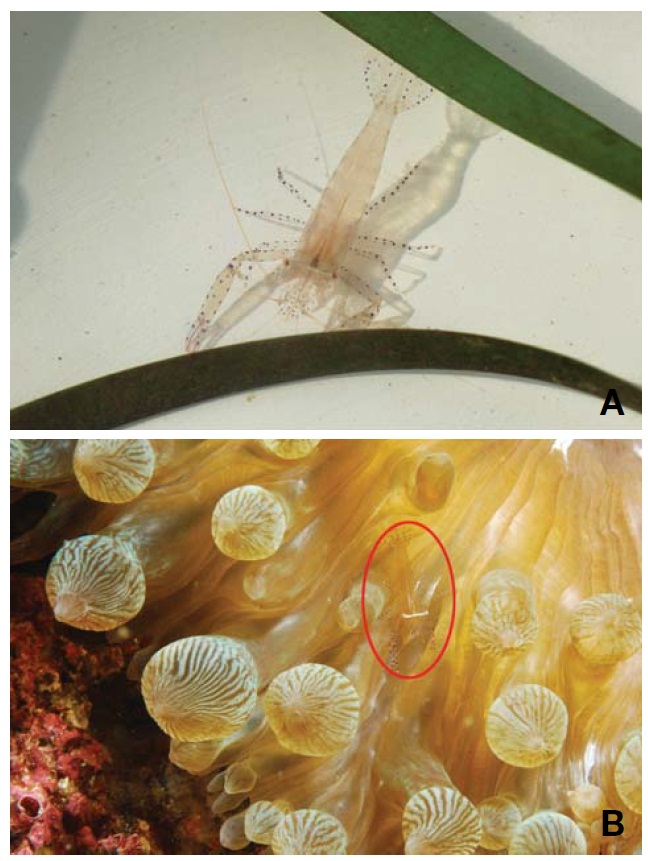



We describe and illustrate two pontoniine shrimps, Cuapetes grandis and Periclimenes ornatus, for the first time in Korea. C. grandis was collected in an artifical reef of Dadae, Geojedo Island by SCUBA diving in 15-20 m depth. This species was found in an oyster within an artificial reef and appeared to be free-living. P. orna-tus was collected from Seongsanpo, Jejudo Island by SCUBA diving in 10 m depth. This species had a symbiotic relationship with sea anemone. This record extends their previously known range from southern Japan to the Korean peninsula and the number of known pontoniine species in Korea to four.
The distribution of pontoniid shrimps extends from tropical to subtropical regions. These shrimps are usually in symbiotic relationships with a variety of other marine species, sponges,coelenterates, molluscs, echinoderms, and ascidians (Bruce, 1983). At present two species of Pontoniinae,
Two species of pontoniine shrimps, collected by SCUBA from Geojedo Island and Jejudo Island, were identified as
Postorbital carapace length is abbreviated as “CL”. It is used as an indication of the size of the specimen and measured from the posterior margin of the orbit to the posterior mid-dorsal margin of the carapace. All specimens were preserved in 95% ethanol. Materials examined in this study are deposit-ed in the second author’s collection of Silla University, Busan.
Order Decapoda Latreille, 1803
Family Palaemonidae Rafinesque, 1815
Subfamily Pontoniinae Kingsley, 1878
1*Genus Cuapetes Clark, 1919
2*Cuapetes grandis (Stimpson, 1860) (Figs. 1- 3)
Material examined. 1♂ (CL 3.8 mm), 1♀ (CL 5.1 mm), Dadae (Geojedo Island), 22 Oct 2008, Lee SH, by SCUBA diving in 15-20 m depth.
Description. Integument smooth on lateral areas of carapace and abdomen. Rostrum (Fig. 1A-C) reaching slightly beyond level of distal end of antennal scale, rostral formula 2+6/2; dorsal teeth rather subequally spaced, posteriormost tooth somewhat separated from remainder of dorsal rostral series, situated posterior to level of hepatic spine. Carapace (Fig. 1A-
C) with supraorbital spine, hepatic spine not noticeably larger than antennal spine, not extending beyond anterior margin of carapace, orbital angle triangular. Abdomen (Fig.1A) without compressed dorsal prominence on 3rd somite, 5th somite pointed, 6th somite approximately 1.5 times as long as 5th.Telson (Fig.1F) with 2 pairs of dorsolateral spines. Eye (Fig.1A) moderately small, cornea well-developed. Antennular peduncle (Fig.1 D) with 1 distolateral spine on basal segment. Scaphocerite (Fig.1 E) approximately 4 times as long as width,distolateral tooth distinctly overreaching distal margin of blade. 1st pereopod (Fig.2 A) overreaching scaphocerite by length of fingers. 2nd pereopod (Fig.2 B, B′) with fingers
0.7 times as long as palm; carpus 0.7 times as long as palm, 3.2 times as long as distal width, with distal spine; merus with distinct distal tooth on flexor margin. 3rd-5th pereopods (Fig.2 C-E) with simple dactyli; flexor margin of propodus with 7 spinules on 3rd pereopod, 8 spinules on 4th pereopod, 5 spinules on 5th pereopod; 5th pereopod not overreaching scaphocerite. Uropod (Fig.1F) overreaching extended telson.
Remarks. The two specimens agree closely with the previous description. Chace and Bruce (1993) described the carpus of the 2nd pereopod was 4 to 5 times longer than the distal width,
but in our specimens it was approximately 3.2 times longer. It is generally accepted that the difference falls within the range of variation for this species. This species was found in an oyster within an artificial reef and appeared to be free-living. It is now the only species within the genus
Color in life (Fig.3 ). Yellowish brown bands are on distal parts of the carpus and the propodus and proximal and distal parts of the fingers on the 2nd pereopod.
Distribution. Red Sea to Mozambique, Japan, Indonesia, Australia (Li and Liu, 2004), and now in Korea.
1*Genus Periclimenes Costa, 1844
2*Periclimenes ornatus Bruce, 1969 (Figs. 4-6)
Material examined. 1♂ (CL 4.1 mm), 2♀♀ (CL 4.8, 4.9 mm), Seongsanpo (Jejudo Island), 18 Oct 2008, Ko HS, by SCUBA diving in 10 m depth.
Description. Integument smooth on lateral areas of carapace and abdomen. Rostrum (Fig.4 A-C) not overreaching scapho-cerite, horizontal, rostral formula 0+6-7/1, posteriormost tooth not isolated from remainder of dorsal rostral series, situated slightly posterior to level of orbital margin, anterior to hepatic spine. Carapace (Fig.4 A-C) without supraorbital or postorbital tooth, hepatic spine not noticeably larger than antennal spine, arising posteriorly and slightly ventrally to level of latter, not extending beyond anterior margin of cara-pace, orbital angle acute. Abdomen (Fig.4 A) without com-pressed dorsal prominence on 3rd somite, 6th somite approx-imately 1.5 times as long as 5th. Telson (Fig.4F) with 2 pairs of well-developed dorsal spines anterior to posterior margin, at approxima-tely 0.3 and 0.6 of length. Eye (Fig.4 A) with cornea hemispherical. Antennular peduncle (Fig.4 D) with 1 distolateral tooth on basal segment. Scaphocerite (Fig.4 E) approximately 2.5 times as long as width, lateral margin stra-ight,distolateral tooth not exceeding distal margin of blade. 1st pereopod (Fig.5 A) with fingers subspatulate, cutting edges entire. 2nd pereopods (Fig.5 B) similar, subequal, with fingers approximately 0.5 times as long as palm, carpus approxima-tely 0.3 times as long as palm, approximately l.7 times longer than width, without distal spines, merus without distal tooth on flexor margin. 3rd pereopod (Fig.5 C, C′) with dactyl not subdistally truncate, without denticulate lobe on flexor mar-gin, simple, not biunguiculate, flexor margin concave, propo-dus with small distoventral spine only, not segmented. 4th-5th pereopods (Fig.5 D, D′, E) similar to 3rd pereopod, pro-podus without small distoventral spine. Uropod (Fig.4F) broad, exceeding tip of telson.
Remarks. Chace and Bruce (1993) described the scaphocerite was 2.5 times longer than the width, but in these specimens
it was 2.7 times longer. It is generally accepted that the dif-ference falls within the range of variation for this species. Omori et al. (1994) reported that this species had a symbiotic relationship with sea anemone such as
Color in life (Fig.6 ). Body is transparent. Scaphocerite, pere-opods and uropods are violet spotted.
Distribution. Red Sea, Kenya, Japan, Hong Kong, Indonesia
(Marin et al., 2005), and now in Korea.

